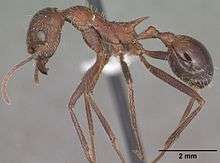Novomessor albisetosus
| Novomessor albisetosus | |
|---|---|
 | |
| N. albisetosus worker specimen | |
| Scientific classification | |
| Kingdom: | Animalia |
| Phylum: | Arthropoda |
| Class: | Insecta |
| Order: | Hymenoptera |
| Family: | Formicidae |
| Subfamily: | Myrmicinae |
| Tribe: | Stenammini |
| Genus: | Novomessor |
| Species: | N. albisetosus |
| Binomial name | |
| Novomessor albisetosus Mayr, 1886 | |
| Synonyms[1] | |
| |
Novomessor albisetosus is a species of ant in the genus Novomessor. It was described by Austrian entomologist Gustav Mayr in 1886.
Taxonomy
Novomessor albisetosus was first identified by Austrian entomologist Gustav Mayr in 1886, who provided the first description of the ant in his journal article Die Formiciden der Vereinigten Staaten von Nordamerika.[2] In his journal, N. albisetosus was originally known as Aphaenogaster albisetosa. In 1895, Italian entomologist Carlo Emery classified Aphaenogaster as a subgenus of Stenamma, and N. albisetosus was renamed as Stenamma (Aphaenogaster) albisetosum.[3] Emery would later transfer the species to the newly erected genus Novomessor, a genus he described in 1915 which included Novomessor cockerelli.[4] In 1947, Jane Enzmann described a new species, Novomessor cockerelli minor. She distinguishes it from N. cockerelli by its smaller size, lighter color and more sculptured body shape.[5] This taxon, however, was synonymized with N. albisetosus two years later.[6]
Novomessor was synonymized in 1974, and so N. albisetosus was moved to Aphaenogaster.[7] However, scientists revived the genus in 1976 and stated that N. albisetosus and N. cockerelli had an exocrine gastral glandular system that was not found in any examined Aphaenogaster ant.[8] In 1982, English myrmecologist Barry Bolton argues that basing the genus on such feature cannot justify the separation of Novomessor and Aphaenogaster.[9] In 2015, a phylogenetic study concluded that Novomessor was genetically distinct from Aphaenogaster, and the genus was revived from synonymy to reinstate N. albisetosus as one of the three known species.[10]
Description
N. albisetosus is a medium-sized species with a moderately short body, measuring 6 to 8.5 millimetres (0.2 to 0.3 in).[2][11] The body color of the ant is ferruginous, the legs are reddish brown and the petiole and abdomen are brownish black. The first segment of the abdomen, however, is brownish yellow. The tibia has fine and clear bristle. The maxillae both form a triangle-shaped isoscele, and the mandibles have three comparatively large teeth. The head is noticeably long, which is longer than its total width. The clypeus is also longer than wide and is found in the middle of the head which forms two vertical stripes.[2]
Distribution and habitat
N. albisetosus is native to Mexico and south-western United States, where it's geographical presence ranges from the U.S. states of Texas, New Mexico and Arizona. In Mexico, the ant is found in the state of Chihuahua. The ant is less common than its relative N. cockerelli.[12][13][14]
References
- ↑ Johnson, N.F. (December 19, 2007). "Novomessor albisetosus Mayr". Hymenoptera Name Server version 1.5. Columbus, Ohio, USA: Ohio State University. Retrieved December 24, 2015.
- 1 2 3 Mayr, G. (1886). "Die Formiciden der Vereinigten Staaten von Nordamerika" (PDF). Verhandlungen der Zoologisch-Botanischen Gesellschaft in Wien. 36: 419–464. doi:10.5281/zenodo.25865.
- ↑ Emery, C. (1895). "Beiträge zur Kenntniss der nordamerikanischen Ameisenfauna. (Schluss.)" (PDF). Zoologische Jahrbücher, Abteilung für Systematik, Geographie und Biologie der Tiere. 8: 257–360. doi:10.5281/zenodo.25455.
- ↑ Emery, C. (1915). "Definizione del genere Aphaenogaster e partizione di esso in sottogeneri. Parapheidole e Novomessor nn. gg" (PDF). Rendiconto delle Sessioni della R. Accademia delle Scienze dell'Istituto di Bologna. 19: 67–75. doi:10.5281/ZENODO.11435.
- ↑ Enzmann, J. (1947). "New forms of Aphaenogaster and Novomessor". Journal of the New York Entomological Society. 55: 147–153. doi:10.5281/zenodo.26332.
- ↑ Brown, W.L. Jr. (1949). "Synonymic and other notes on Formicidae (Hymenoptera)". Psyche: A Journal of Entomology. 56 (1): 41–49. doi:10.1155/1949/54570.
- ↑ Brown, W.L. Jr. (1974). "Novomessor manni a synonym of Aphaenogaster ensifera (Hymenoptera: Formicidae)" (PDF). Entomological News. 85: 45–47.
- ↑ Hölldobler, B.; Stanton, R.; Engel, H. (1976). "A New Exocrine Gland in Novomessor (Hymenoptera: Formicidae) and its Possible Significance as a Taxonomic Character". Psyche: A Journal of Entomology. 83 (1): 32–41. doi:10.1155/1976/28626.
- ↑ Bolton, B. (1982). "Afrotropical species of the myrmicine ant genera Cardiocondyla, Leptothorax, Melissotarsus, Messor and Cataulacus (Formicidae)" (PDF). Bulletin of the British Museum (Natural History). 45 (4): 307–370.
- ↑ Demarco, B.B.; Cognato, A.I. (2015). "Phylogenetic Analysis of Aphaenogaster Supports the Resurrection of Novomessor (Hymenoptera: Formicidae)". Annals of the Entomological Society of America. 108 (2): 201–210. doi:10.1093/aesa/sau013.
- ↑ Wheeler, W.M.; Creighton, W.S. (1934). "A Study of the Ant Genera Novomessor and Veromessor" (PDF). Proceedings of the American Academy of Arts and Sciences. 69 (9): 341–388. doi:10.2307/20023057. JSTOR 20023057.
- ↑ Smith, M.R. (1947). "A generic and subgeneric synopsis of the United States ants, based on the workers (Hymenoptera: Formicidae)". American Midland Naturalist. 37 (3): 521–647. doi:10.2307/2421469.
- ↑ Smith, D.R. (1979). Superfamily Formicoidea. Pages 1323-1467 in Krombein, Hurd, Smith & Burks. Catalog of Hymenoptera in America north of Mexico. Volume 2. Apocrita (Aculeata) (PDF). Washington, D.C.: Smithsonian Institution Press. p. 1360.
- ↑ Mackay, W.; Mackay, E. (2002). The ants of New Mexico: (Hymenoptera:Formicidae). Lewiston, N.Y.: Edwin Mellen Press. p. 63. ISBN 978-0-7734-6884-9.
External links
 Media related to Novomessor albisetosus at Wikimedia Commons
Media related to Novomessor albisetosus at Wikimedia Commons